

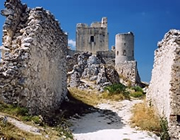
Staying in the excellent Hotel Castello Chiola in Loreto Aprutino we made excursions to the Roman ruins of Saepinum, the Villa Adriana at Tivoli (described on the Rome page) and Alba Fucens; up into the mountains to the Campo Imperatore and to numerous towns and villages for the art, architecture and excellent food.
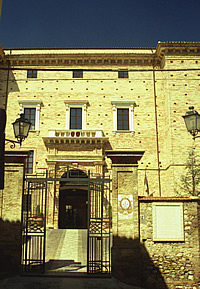
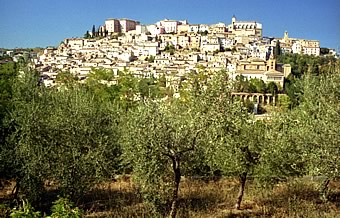
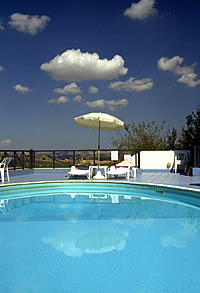
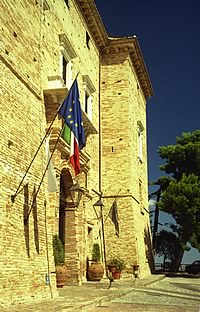
Loreto Aprutino is a small hilltop town some 28km west of Pescara. Surrounded by olive groves and basking in the sunshine it is an attractive and little-visited spot with a superb hotel and some fabulous frescoes.
The Hotel Castello Chiola, originally a ninth century castle, stands at the summit of the hill at the head of Via del Baio, itself lined with palazzos. Our room was vast and luxurious. We enjoyed excellent food in the vaulted restaurant - although the only Italian wines available seem to be those from the Abruzzo.
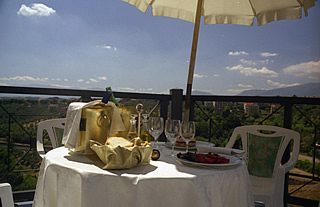
We made good use of the swimming pool on this trip, forcing ourselves to devote at least a couple of days to relaxation - days with lunch by the pool and a good book. It was very hot while we were here so the shade of the poolside umbrella was most welcome. The only drawback for me were the wedding receptions held in the interior courtyard which were disturbingly loud late at night.
The church of Santa Maria in Piano is well-worth visiting for its very beautiful 14th century frescoes of the Last Judgement.
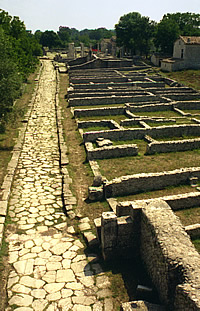
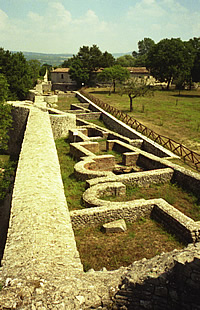
The drive to Saepinum (in the Molise) took over two hours on mountain roads - great driving, especially the ascent above Pettarono (not so enjoyable if you're of a nervous disposition though).
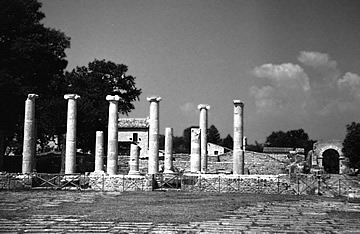
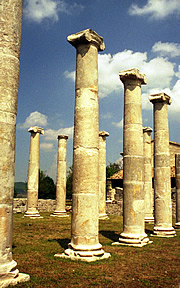
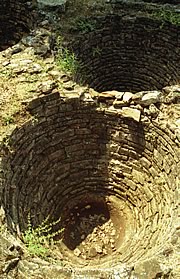
Saepinum is worth the effort - little visited so mostly devoid of tourists and "the best example in Italy of a provincial Roman town" (Rough Guide) - mainly because it was never very important, reaching its peak in the first 200 years AD.
The Romans took the town from the Samnites in 293BC, its importance being its location at the crossroads of two major routes on which it lay: one north-south between the Abruzzo and Puglia, traditionally used by herdsmen as they moved their stock seasonally; and the second a major east-west route from the sea into the mountains. The former became the Roman cardo, the latter the decumanus within Saepinum.
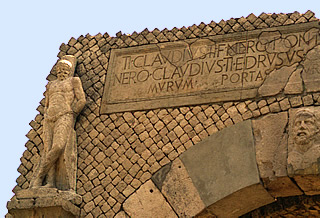
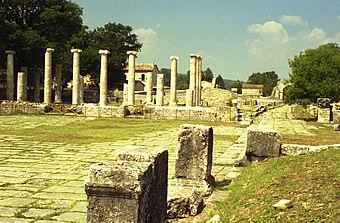
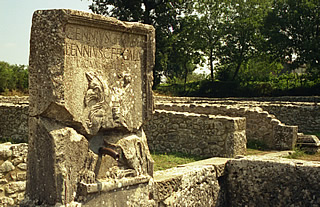
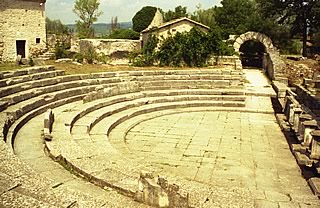
The most important occupations would have been agricultural: wool, olives, grapes and wheat.
At the western end of the decumanus maximus lies the well-preserved gate Porta Boiano. The statues either side of the arch are of prisoners captured after battle and the inscription is to Tiberius, the step-son and successor of the Emperor Augustus.
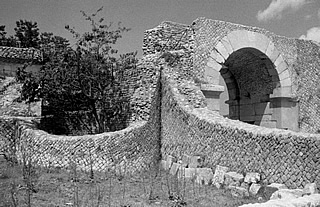
When eventually abandoned the town simply decayed back into the landscape. Originally it was surrounded by a wall punctuated with round towers but this has mostly long gone and the edges of the site are overlapped by small farms.
The forum in the centre of the town, where the two main streets - the cardo and the decumanus - cross, is easily identifiable, flanked by the remains of major public buildings. The first century AD basilica - for Romans a public building for meetings and business transactions - is located at the junction, its columns well-preserved.
The theatre is located right on the edge of the town and is now backed by a curving row of farmhouses.
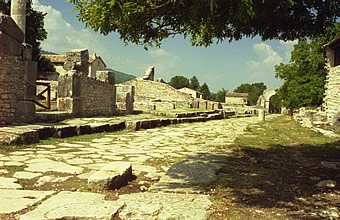
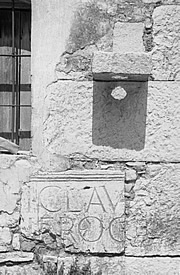
The town is small and can be explored fully at a leisurely pace. Not many people get here and it is peaceful and easier than many other Roman towns to visualise the people going about their daily lives.
There is a small cafe here where we had a decent lunch of a sandwich and a beer.

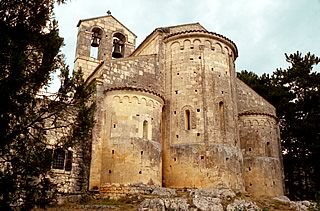
A pleasant drive to visit the famous frescos of Andrea Delitio in the 13th century cathedral of Santa Maria Assunta in Atri. These 15th century works of art are beautifully colourful and full of detail of the local landscape and domestic life in which the religious scenes are embedded. The Slaughter of the Innocents is quite horrific! I would recommend a visit for these frescoes alone for anyone who appreciates Renaissance art. The cathedral is built on the site of a Roman baths and a mosaic floor from the baths can be seen through a glass panel set in the floor of the cathedral.
Two beautiful churches are the reason to visit Bominaco south of L'Aquilla. The Abbey of Santa Maria del'Assunta has the three apses typical of the Romanesque style, simple and elegant, and an interior graced by beautiful white marble columns. The smaller San Pellegrino is of much more basic architectural design but the frescoes inside are stunning. These are from the 13th century and thought to pre-date Giotto in their use of perspective and human expression. No photography allowed, of course.
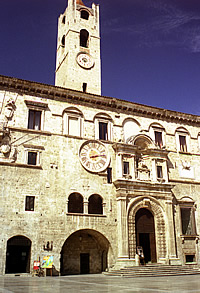
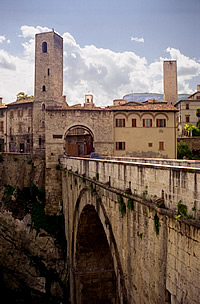
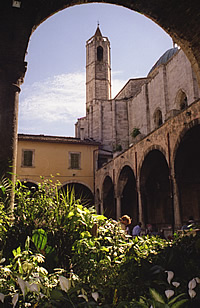
We drove to Ascoli Piceno via the motorway - thank heaven for air conditioning. The town is named for the ancient Piceni tribe which once occupied this area.
The 13th century Palazzo dei Capitani del Popolo in the Piazza del Popolo is a very attractive building and the piazza itself spacious and paved with travertine marble.
We had come to the city principally to visit a recommended restaurant and to see the famous Roman bridge which is indeed huge.
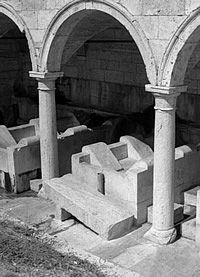
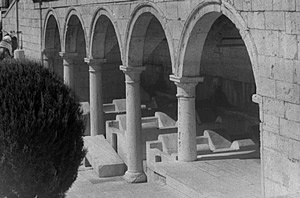
Across the bridge is a public laundry under delicate arches - not sure from when it dates but it must be many hundreds of years old. The stone troughs fed with unheated water have built-in sloping boards on which to scrub the laundry,. with room for twelve women.
The small cloister of San Francesco hwas occupied by a few market traders where once monks would have meditated in silence.
Lunch was not a success apart from a wild boar pasta - my wild boar main course being mostly barley which I detest.
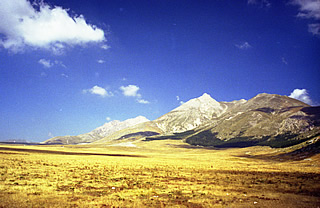
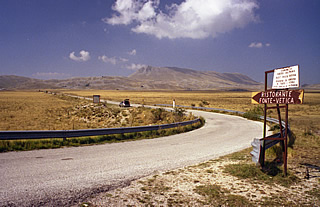
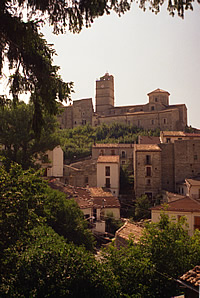
Drive west from Loreto Aprutino, via Penne towards Gran Sasso, and you climb up into the mountains. Suddenly the landscape flattens into a vast, prairie-like plain, the Campo Imperatore - most bizarre this high up.
On the southern edge of the plain is the medieval village of Castel del Monte which we found not so forbidding as the Rough Guide describes, although we were ripped off on a bottle of wine here.
From Castel del Monte we went on to Rocca Calascio, a deserted hillside village with a crumbling castle at its peak. We had our picnic at a fountain in the shade just before the ascent to the village.
As we toiled up the hillside we came to a restaurant, closed, but from the window Figaro's aria from the Barber of Seville was loudly playing. We sat at a shaded restaurant table and thoroughly enjoyed the wondeful music in a perfectly atmospheric setting - hot, deserted Italian countryside.
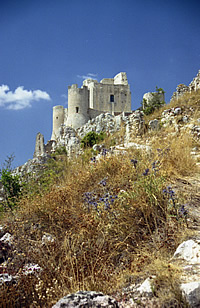
The Rocca Calascio fortress is the highest in the Appenines at almost 1500m and was begun in the tenth century as a single watchtower. It was purely intended for defensive purposes it never saw action but was later badly damaged by an earthquake. Around its flanks was a village, now completely deserted. It is a very atmospheric place to wander around; we saw ruined houses with pizza ovens and caves at the rear, and the castle is spectacular.
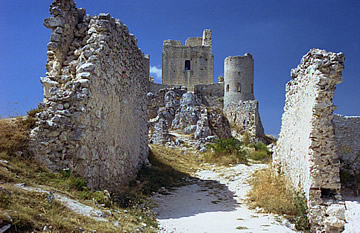
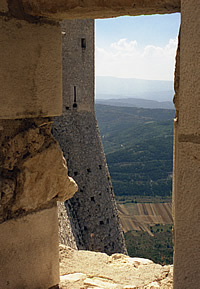
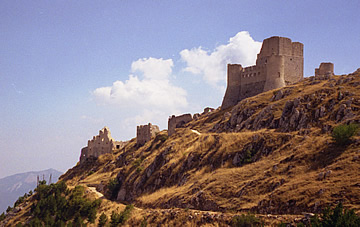
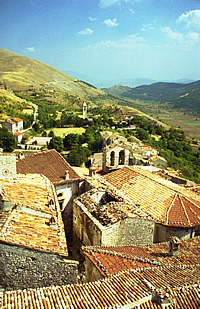
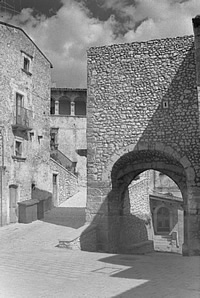
We finished our tour this day at San Stefano di Sassanio, another village which appears to be deserted but is obviously not abandoned.
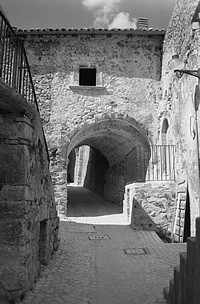
Cool passageways, stone arches over tiny streets and some very ornate windows. We used our last reserves of energy to climb the tower for excellent views of rooftops and surrounding mountains before returning to the hotel for a welcome shower and dinner.
Many of the houses seemed to be crumbling. According to the Rough Guide it was a Medici stronghold in the fifteenth century.
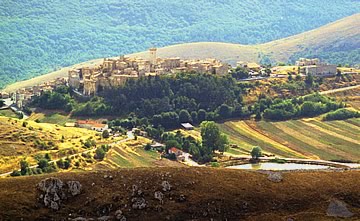
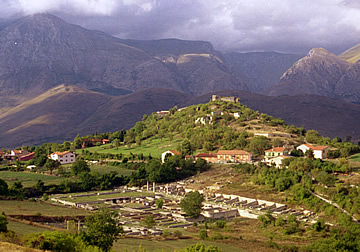
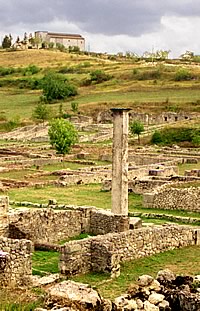
We had made a long excursion to Hadrian's Villa at Tivoli and endied up having a very late but truly excellent lasagne at the Restaurant Drogo as we approached Alba Fucens. We spotted the restaurant perched on the hillside and took a chance - it was a real find.
Alba Fucens is a wonderful place. We were just going to make a short stop but spent some time just wandering about - it helped that it was cooler later in the afternoon.
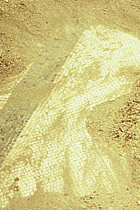
It was deserted apart from us and the ruins were unfenced and we found ourselves wandering over what looked like unexcavated mosaics!
Originally an ancient town of the Aequi people, it became a Roman garrison town in 303 BC to keep surrounding tribes under control and was of great strategic importance.
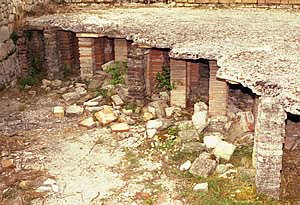
There are remnants of roads - the major one colonnaded - and the courses of houses and shops, bits of hypocaust and an amphitheatre.
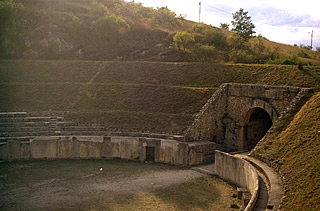
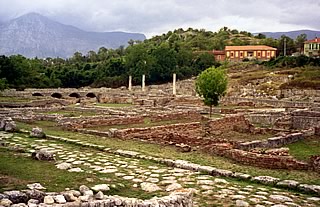
It lies in a flat valley at the foot of Mount Velino which is a shade under 2500m high. There are excellent views from the Romanesque church of San Pietro on a nearby hill but this was locked when we visited.
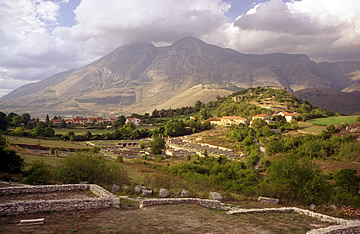

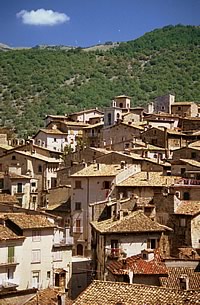
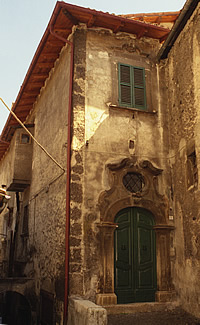
A lovely drive through mountains and passing lakes to Scanno - a medieval village surrounded by mountains.
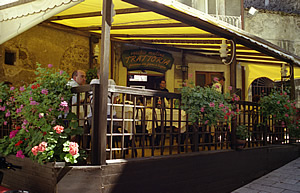
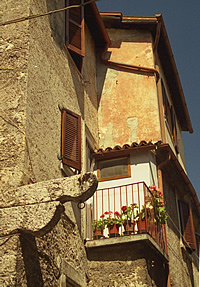
We had one of our best meals here at Trattoria Il Vecchio Mulino - ravioli followed by lamb.
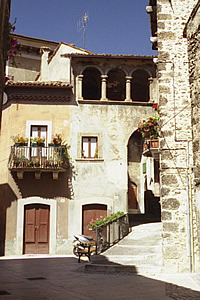
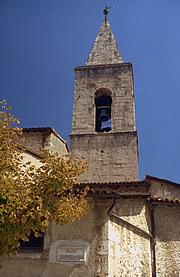
The old town is lovely, the houses of weathered stone with ornate doorways and loggias speaking of past glories. In August the streets were pretty much deserted because of the heat!
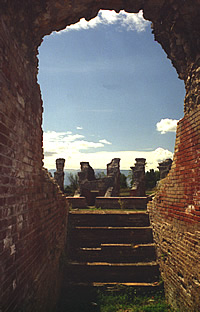
Amiternum is just north of L'Aquila and has some interesting Roman remains, in particular the theatre and amphitheatre, though there's not really much here. Originally a Sabine settlement it became Roman in 290BC. The name probably drives from the river Aterno. This is another Roman town which owed its prosperity to its situation at the junction of major roads.
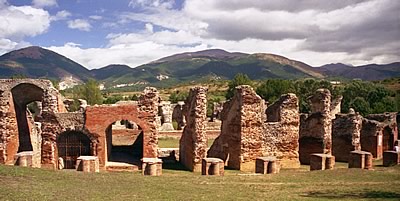
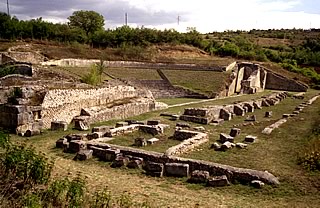
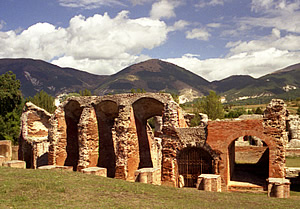
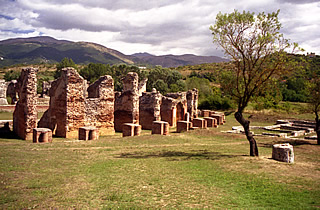
We were not impressed by Lanciano - perhaps it was just the heat. But after the visit we drove down the coast, visiting the Sangro River War Cemetery - beautifully kept as always - before a good pizza at Mare Blu. Afterwards we skimmed pebbles in the sea and stopped at the Canadian War Cemetery before driving back to the hotel.
Nor did Chieti appeal, there are much better Roman remains within driving distance than the three Roman temples - though we didn't visit the museum which is said to be of most interest here.
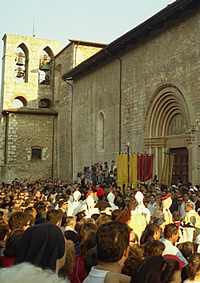
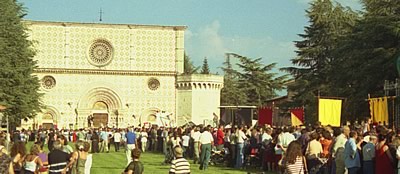
We made a couple of visits to L'Aquila - driving through Campo Imperatore was something we enjoyed! We didn't find anything particularly appealing in the town itself.
Our first visit was on a Sunday and there didn't seem to be much choice in places to eat so we took the Rough Guide's advice and chose the Stella Alpina. We were not disappointed - a huge plate of penne pomodori was particularly good.
Our second visit was to see the ceremony of the Opening of the Holy Door of Santa Maria di Collemaggio.
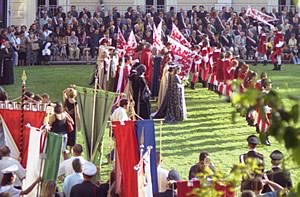
The church itself is a very beautiful Romanesque building. The west front is formed of pink and white stone to form a sequence of crosses. A hermit who had a vision here founded the Celestine order and built the church. He was crowned Pope Crestine V here on 29th August 1294 and decreed that henceforth anyone who came to the church on the 28th August and repented their sins would be forgiven. Every year on August 28th the north door is opened and crowds pass through into the basilica.
The basilica was badly damaged in an earthquake in 2009 but the beautiful west front survived. The town and surrounding villages also suffered much damage with over 200 killed and many thousands made homeless.
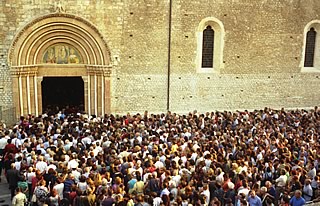
The actual door opening is preceded by a festival and the town itself is closed so it is necessary to park on the outskirts. We walked up to the church where there were masses of people. There was a parade of, we think, local historical societies from surrounding towns and villages dressed in magnificent medieval costumes, some recognisable from renaissance paintings - I spotted a red hat from the Piero della Francesca painting of the Duke of Urbino in the Uffizi. Bands were mostly drums and there was flag throwing which is also popular in Switzerland! Several speeches and too many dignitaries and officials and a real live cardinal who seemed to wing his speech in front of a large TV screen showing the Pope. The door duly opened and there was an unholy scramble to get through.